Multi-response optimization of process parameters in friction stir welded AM20 magnesium alloy by Taguchi grey relational analysis
*
Department of Mechanical Engineering,Indian Institute of Technology Guwahati,781039 Assam,India
Multi-response optimization of process parameters in friction stir welded AM20 magnesium alloy by Taguchi grey relational analysis
Prakash Kumar Sahu,Sukhomay Pal*
Department of Mechanical Engineering,Indian Institute of Technology Guwahati,781039 Assam,India
The purpose of this paper is to optimize the process parameter to get the better mechanical properties of friction stir welded AM20 magnesium alloy using Taguchi Grey relational analysis(GRA).The considered process parameters are welding speed,tool rotation speed,shoulder diameter and plunging depth.The experiments were carried out by using Taguchi's L18factorial design of experiment.The processes parameters were optimized and ranked the parameters based on the GRA.The percentage infuence of each process parameter on the weld quality was also quantifed.A validation experimental run was conducted using optimal process condition,which was obtained from the analysis,to show the improvement in mechanical properties of the joint.This study also shows the feasibility of the GRAwith Taguchi technique for improvement in welding quality of magnesium alloy.
Friction stir welding;Magnesium alloy;Tensile strength;Bending strength;Micro-hardness;Optimization;Taguchi;Grey relational analysis
1.Introduction
Magnesium alloys are promising material for their attractive properties to replace aluminum and steel in structural and mechanical applications.It has outstanding stiffness-to-weight ratio,high damping capacity,lowest density among engineering metallic materials and ease of recyclability[1]. Nowadays magnesium alloys are used for many practical applications due to its light weight in place of aluminum alloy [2].Volkswagen was the frst automobile company which used 22 kg magnesium alloys on its Beetle model.The magnesium alloys products are used in automotive industry like seat frame (GM),door inner,steering wheel core,steering column(Ford, Toyota,BMW),lift gate,instrument panel(GM,Ford, Toyota),transfer case(Volvo),engine parts(BMW),automotive wheels(Toyota),electronic products,vibrating plates of vibrating test machines etc.The use of magnesium alloys reduces the total weight of component about 22%-70%instead of alternate material like aluminum and steel,so at the same time reduces the fuel consumption and the CO2emissions[3]. The main problem in case of magnesium alloy components welded by conventional welding process are its low strength, hot cracking,alloy segregation,partial melting zone and porosity in the welded joint.So that the mechanical properties and corrosion resistance decreases[4-6].To overcome the above mentioned drawback,friction stir welding(FSW)process can be used to weld magnesium alloys.
FSW is an advanced welding process and has emerged as an important solid state joining process.At frst it was used for welding aluminum alloys but now the research of FSW has been extended to a variety of materials including magnesium, copper,steels and composites.In this process,the welded material is plasticized by heat generated due to the frictionbetween the surface of the plates or components to be welded and the contact surface of a special rotating tool.A schematic diagram of the FSW process is shown in Fig.1.The steps of the process are:clamping and positioning of workpiece and tool,tool plunging into the workpiece,tool traversing along the joint line and tool removal after completion of welding. The FSW tool consists of three distinct parts namely,shank, shoulder and pin.Shank is used for holding purpose and shoulder and pin generate frictional heat on the workpiece. Shoulder is mainly responsible for the generation of heat and containing the plasticized material in the weld zone,while pin mixes the material of the components to be welded,thus creating a joint.
Even though the FSW process offers many advantages, very less number of investigations has been carried out on FSW of magnesium alloys.Razal Rose et al.[7]studied the effect of axial force on tensile properties of AZ61A magnesium alloy.They found that 5 kN axial force,which was varied from 3 kN to 7 kN,exhibits superior tensile properties.Chen et al.[8]investigated the effect of grain size on mechanical properties of AMX602 magnesium non-combustive alloy. Commin et al.[9]investigated the processing parameters and the properties of welded joint of AZ31-O magnesium alloy and discussed the potential for using FSW in the aircraft industry.Rajakumar et al.[10]did parametric study on FSW of AZ61A magnesium alloy.They developed an empirical relationship to predict tensile properties.Harikrishna et al.[11] used FSW process to weld ZM21 magnesium alloy and studied the tensile strength and bending strength.They found that tensile strength was 75%of base material and welded joint band up to 65°.Chai et al.[12]reported strain rate and tensile strength of friction stir processed(FSP)AZ91 magnesium alloy.Padmanaban et al.[13]compared three welding processes namely,gas tungsten arc welding(GTAW),FSW and laser beam welding(LBW).They found that LBW exhibit 14%higher strength compared to GTAW and 2%compared to FSW.Razal Rose et al.[14]studied the infuence of welding speed on tensile properties of friction stir welded AZ61A magnesium alloy.They found that the welding speed was the main causes for the formations of fne grain in the stir zone which leads to higher hardness and acceptable tensile properties.Balamurugan et al.[15]investigated the effect of tool profle on mechanical and tribological properties of FSP AZ31B magnesium alloy.They used concave and stepped type shoulder and studied the grain size,corrosion rate,tensile properties,and tool wear.Nia et al.[16]examined the effect of thread pitch and water cooling action on the mechanical and microstructural properties of FSP AZ31 magnesium alloys. They found that the thread pin with 1 mm pitch improved mechanical properties and microstructure uniformity than the pin with 3 mm pitch.Yu et al.[17]studied microstructural modifcation and mechanical properties improvement in friction stir zone of thixo-molded AE42 magnesium alloy.They found that the grain became fner when welding speed increases and the stir zone hardness and tensile strength increases due to refne of grain.Microstructural and mechanical properties of friction stir welded AZ31B magnesium alloy added with cerium was studied by Sirong et al.[18].It was found that tensile properties added with cerium was more compare to without cerium and the micro hardness in the weld nugget slightly lower than that in the base material.
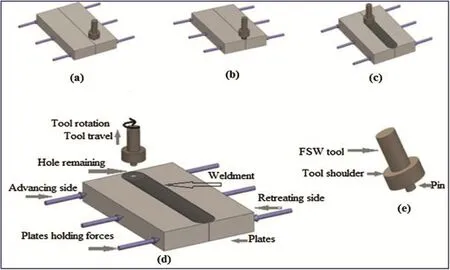
Fig.1.Schematic representation of FSW process:(a)positioning plates and tool before plunging,(b)plunging of the pin,(c)tool traversing along the joint,(d)pin removal and e)schematic of an FSW tool.
Chien et al.[19]optimized the FSW process parameter using Taguchi grey relational analysis for Al alloy.They found that the most signifcant process parameter is tool pin length and tool tilt angle is insignifcant parameter.Datta et al.[20] studied the feasibility of the Grey-based Taguchi techniquefor improvement in welding quality of submersed arc welding process.Aydin et al.[21]found that Taguchi method is a very effective tool for process optimization under limited number of experimental runs.Experimental results showed that tensile strength and elongation of welded AA1050-H22 aluminum alloy are greatly improved by using Grey based Taguchi method.Vijayan et al.[22]studied the optimization of process parameters in FSW of aluminum alloy AA5083 with multiple responses based on orthogonal array with grey relational analysis.Their objective was to fnd the optimum levels of the process parameters in which it yields maximum tensile strength and consumes minimum power.Kasman[23]studied on multi-response optimization fordissimilarFSW of AA6082-AA5754 aluminum alloys.He found that Taguchi based grey relational analysis can be successfully used to optimize dissimilar FSW process.
From the literature,it is found that published information on FSW of magnesium alloys are less as compared to very wide research on aluminum alloys.Further,most of the researchers considered only few weld quality parameters(not more than three parameters)and also optimization technique was not used to optimize the process parameter settings for Mg alloys.Therefore in this work,Taguchi Grey relational analysis technique was applied to optimize the multiple quality characteristics of friction stir welded AM20 magnesium alloys.The algorithm applied here was successfully used for both detraining the optimum process parameters settings and for combining multiple quality characteristics into one integrated numerical value called Grey relational grade. Experiment was conducted using Taguchi's L18factorial design of experiment.The percentage contribution of each process parameter was also determined using analysis of variance(ANOVA).
2.Experimental work
In this investigation,AM20 magnesium alloy with dimension of 100×100×4 mm was used to get square butt joint in single pass weld.The chemical composition,in weight percentage,of the AM20 is Al-2.03%,Mn-0.43%,Zn-0.18%,Si-0.04%and the balance is Mg which was found from the EDX test.The mechanical properties of the base material are given in Table 1.The plates were properly positioned and clamped using a special fxture.The tool used in this work was H13 tool steel having shoulder diameter of 16-24 mm,pin diameter 6 mm and pin length 3.5 mm.There are large numbers of independent parameters which can control the FSW process. Some preliminary experiments were conducted in order to determine important parameters and their range.Four process parameters namely,tool rotation speed,welding speed,shoulder diameter and plunge depth were considered in this investigation.The level of each parameters were considered on the basis of one level above and below to the normal operating level,where successful welding can be obtained.Three parameters in three levels and one parameter in two levels were varied,which are shown in Table 2.Plunging depth was varied in two levels because in higher plunging depth welded zone becomes thinner compared to the base metal which causes less effective strength.

Table 1Mechanical properties of the base material.
In order to minimize the number of experiments Taguchi's L18factorial design of experiment was adapted in this work, design matrix is given in Table 3.Eight weld quality parameters,namely ultimate tensile strength(UTS),yield strength (YS),percentage of elongation(%E),compressive stress (CS),bending angle,average hardness at the nugget zone (NZ),thermo mechanical affected zone(TMAZ)and heat affected zone(HAZ)were measured after the experiment and are given in Table 4.Tensile specimens were prepared as per ASTM E8 standard dimensions and tested in universal testing machine(Make:INSTRON,Model 8801).One tensile testing specimen is shown in Fig.2.The maximum UTS and YS of the welded joint are 132.17 MPa and 115.56 MPa which are 65%and 72%of the base metal,respectively.The maximum bending angle of the welded sample is 90°in case of Exp. No.14,which is shown in Fig.3,whereas the base metal maximum bending angle is slightly more than 90°.The hardness was also measured and the overall hardness is shownin Fig.4,it was found that Exp.No.9 gives highest hardness values at various zones.From the tensile fractured surface, shown in Fig.5,it was found that there are very less dimples on the fractured surface which indicates that the type of fracture is not pure ductile fracture.

Table 2Process parameters with their levels.

Table 3Taguchi's L18design matrix.
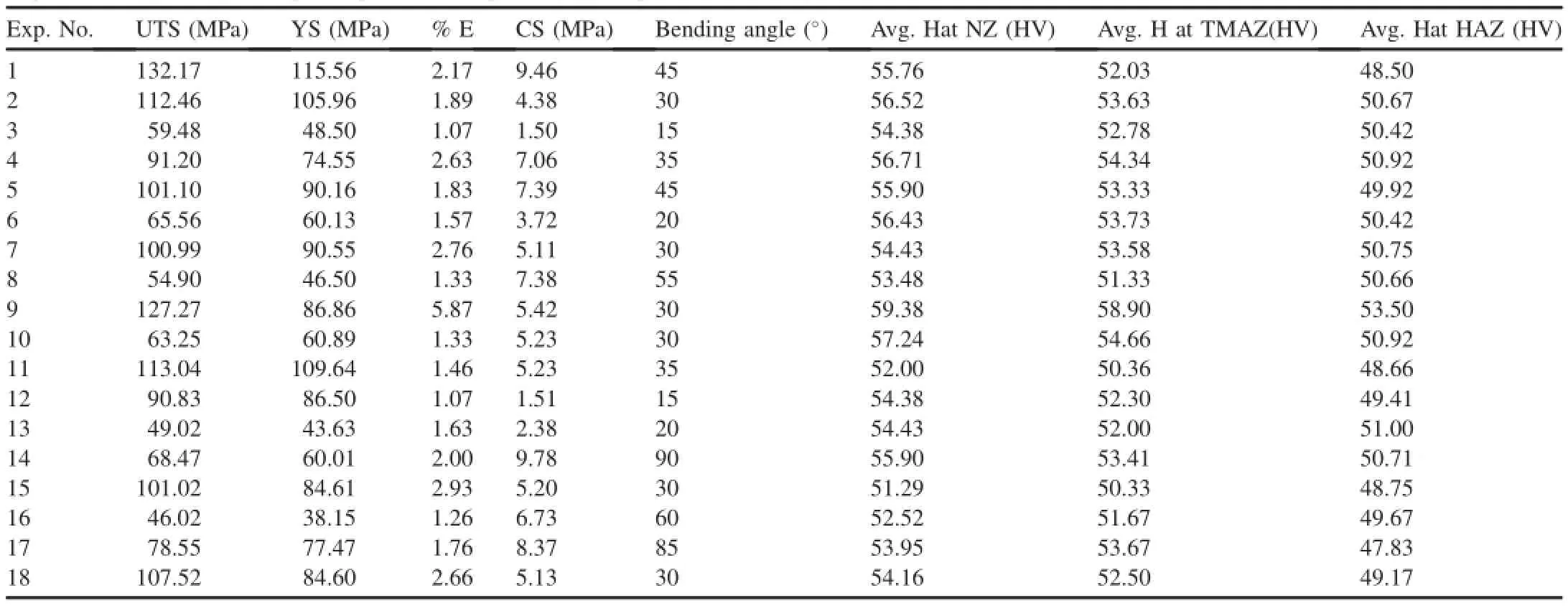
Table 4Experimentally measured output responses corresponding to the parameters setting mentioned in Table 3.
3.Taguchi grey relational analysis
Genichi Taguchi developed a method based on orthogonal array of experiments,which provides much reduced variance for the experiment with optimum setting of process control parameters.In order to evaluate the process parameters,the Taguchi method uses a statistical measure of performance, called as signal-to-noise(S/N)ratio.The S/N ratio is a logarithmic function of desired output serves as objective functions for optimization.The S/N ratio is the ratio of the mean(signal) to the standard deviation(noise).This ratio is a measure of robustness used to identify control factors that reduce variability in a product or process by minimizing the effects of uncontrollable factors.The standard S/N ratios generally used are categorized as Nominal the best(NB),Lower the better (LB)and Higher the better(HB).The S/N ratio for each quality characteristic can be computed independently and regardless of the category of the performance characteristics,a larger S/N ratio corresponds to better quality characteristics. However,the traditional Taguchi method cannot optimize multi objective optimization problem.To overcome this, Taguchi method is combined with Grey relational analysis (GRA)to optimize multi objective problems.
The Grey system theory,was proposed by Deng in 1982,is mainly used to study uncertainties in system models,analyze relations between systems,establish models and make forecasts and decisions.In GRA,experimental data are frst normalized in the range of zero to one,called grey relational generation.Based on that normalized data the grey relational coeffcient is calculated to represent the correlation between desired and actual experimental data.Then overall grey relational grade is calculated by averaging the grey relational coeffcient for the respective responses.So the multi responseproblem can be converted into a single response process optimization problem with overall grey relational grade (GRG)as objective function.Then the last step is to perform the analysis of variance(ANOVA)and prediction of optimal GRG.The details of all the steps required to do the GRA are given as follows:

Fig.2.Tensile tested specimen.

Fig.3.Bending tested specimen.
The data collected from the experiments are normalized in the range of 0-1.If the objective is to minimize the response then LB criteria is used to normalize the reference sequence using Eq.(1)[20].If the objective is to maximize then HB criteria is used to normalize the reference sequence using Eq. (2)[20,23].

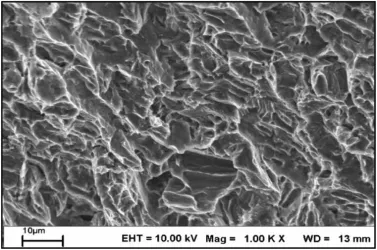
Fig.5.SEM morphologies of fracture surface of Exp.No 1.
where,xi(k)is the value after the grey relational generation,min yi(k)is the smallest value ofyi(k)for thekth response,andmax yi(k)is the largest value ofyi(k)for thekth response.i=1,2,3…the number of experiments andk=1,2,3…the number of responses.
Next,grey relation coeffcient(GRC)is calculated to identify the relationship between the reference sequence and compatibility sequence.The GRC(ξ)can be calculated using Eq.3[23].

where,Δ0i(k)=‖x0(k)-xi(k)‖=difference of the absolute value ofx0(k) andxi(k);ψ is the distinguishing coeffcient;0≤ψ≤1,Δminis the smallest value of Δ0i(k)Δ and Δmaxis the largest value of Δ0i(k).The GRG(γ)is the mean GRC and can be calculated using Eq.(4).It provides the information about the relationship among the sequences.Its value lies in the range of 0 to 1.

where,nis the number of process responses.Optimal value of GRG can be predicted by using the Eq.(5).

where γmis the total mean of theGRG,qis the number of input parameters,and γiis the mean GRG value at the optimal level for theithparameter.ANOVA method is also used to fnd the statistical signifcance of each factor and the percentage contribution of each process parameter on the responses.
4.Implementation of Taguchi GRA for selection of optimal parameter settings
In the present investigation,Taguchi GRA has been applied for selection of optimal parameter settings.All the eightoutput responses(shown in Table 4)were normalized by using either Eqs.(1)or(2).Two cases have been considered for optimization:Case-1- all the quality parameters were considered as“higher the better”i.e.,the objective of Case-1 is maximization of all quality parameters.In Case-2-UTS,YS, CS,and bending angle were considered as“higher the better”and percentage elongation and average hardness values at NZ, TMAZ and HAZ were considered as“lower the better”,i.e., the objective of Case-2 is maximization of UTS,YS,CS,and bending angle and simultaneously minimization of percentage elongation and hardness values.Depending upon user's choice or requirement either Case-1 or Case-2 can be used.This is because some applications need higher values of the quality parameters.In that condition,Case-1 is suitable,whereas Case-2 is suitable if tensile property should be high and hardness should be low.
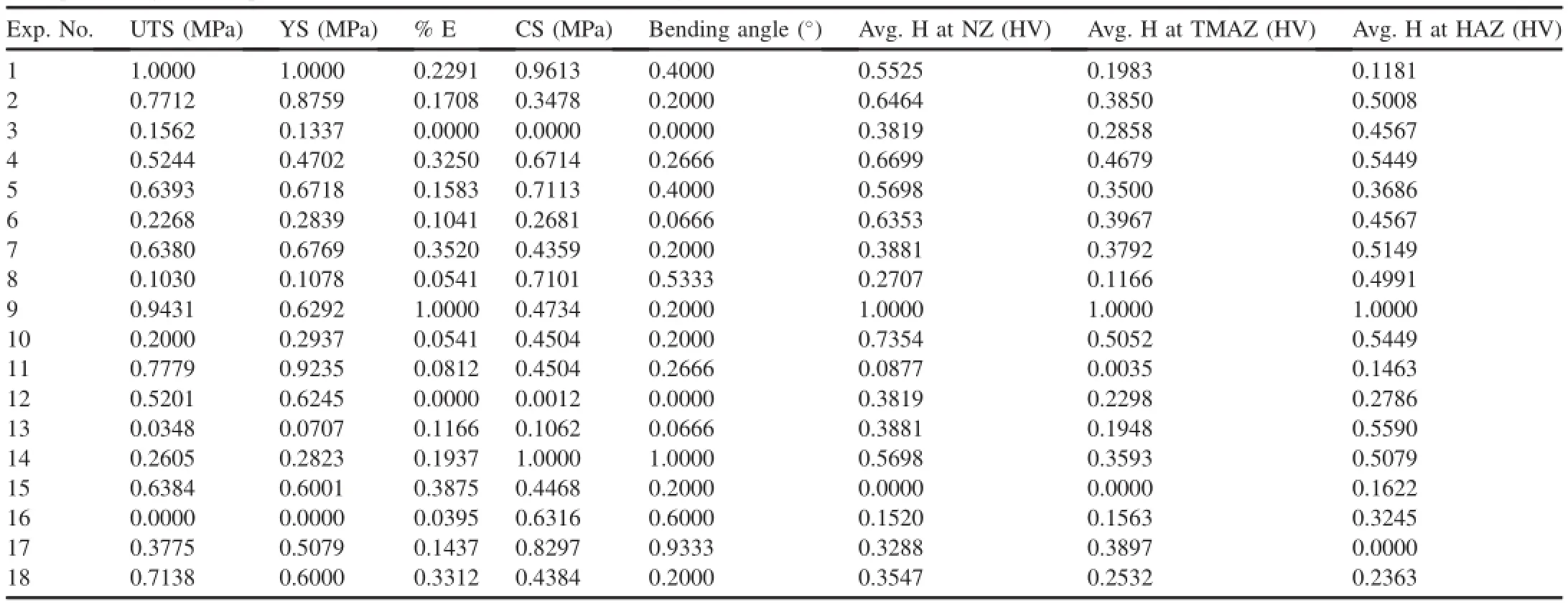
Table 5Data processing of each performance characteristic(Grey relational generation).
4.1.Case-1:all the output responses are taken as“higher the better”
The output responses were normalized by considering HB criteria using Eq.(2),normalized data are given in Table 5. Then the GRCs were calculated by using the Eq.(3).And fnally,GRGs were calculated using Eq.(4).In this step,the multiple performance characteristics were converted into a single GRG value.The GRG values and corresponding S/N ratio of all the experiments are given in Table 6.It was found that the GRG values vary between 0 and 1.ANOVA analysis, shown in Table 7,was also performed to fnd the statistical signifcance and percentage contribution of each parameter. The ANOVA separates the total variability into contributions of each process parameter and the error.
It can be seen in Table 7 that the factor SD has highest contribution(26.56%)on the total variability,next the factor PD with 8.94%.However,the contributions of RPM and WS are low.Moreover,the contribution of error term is 57.99% which is more than the total contribution of all the considered factors.This may be due to the interaction effects of the design parameters which were not considered separately in this analysis.Therefore,to estimate the contribution of twofactor interactions on the responses,ANOVA was performed again by considering 3 two-factor interactions,which is shown in Table 8.It can be seen in Tables 7 and 8 that the contributions of all the design parameters remain same.The ANOVA in Table 8 indicates that the interaction effects of RPM×SD and PD×SD are very high compared to PD×RPM.The relative contribution on the total variability of factors and interactions are found in the order of SD, PD×SD,RPM×SD,PD,PD×RPM,WS,and RPM.The errorcontribution is at acceptable level of 2.65%compared to 57.99%originally.
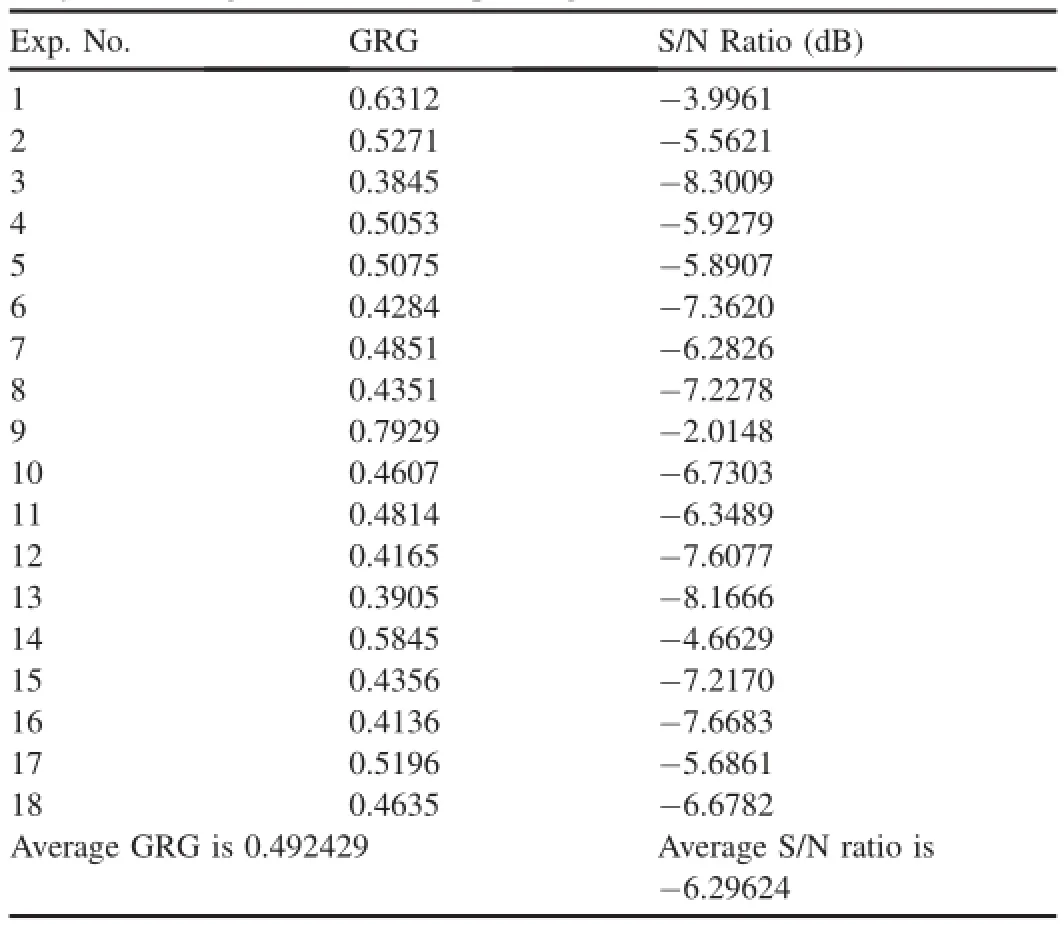
Table 6Grey relational grades with corresponding S/N ratios.

Table 7ANOVA of the S/N ratio for grey relational grade.
The mean S/N ratio for each factor at different levels are calculated and shown in Table 9.The mean effect plot of process parameters on the GRG is also shown in Fig.6.Based on the mean effect plot(Fig.6),the optimal parametric combination for this multi-criterion optimization problem is found to be at levels 1,3,2 and 3 of factors plunge depth,tool rotation speed,welding speed and shoulder diameter,respectively.The prediction of optimal S/N ratio is calculated using Eq.5 and is given in Table 10.To verify the predicted S/N ratio value,a confrmation experiment was carried out by using the optimal parameter combinations.The optimal parameters are plunging depth at 0.12 mm,rotational speed at 1100 RPM, welding speed at 98 mm/min and shoulder diameter at 24 mm. The output results of the confrmation experiment are given in Table 10.The increase of the S/N ratio value from the initially best result(Exp.No 1,which had maximum S/N ratio value)to the optimal experimental conditions is about 0.0229 dB.It also found that the percentage of error with the predicted and experimental data is 10.93%.
4.2.Case-2:some of output responses taken as“higher the better”and other are taken as“lower the better”
In this case,the output responses,namely UTS,YS,CS, and bending angle are normalized using HB criteria by using the Eq.2.Percentage elongation and average hardness values at NZ,TMAZ and HAZ are normalized using LB criteria by using the Eq.(1).All the steps to calculate the GRG values are followed as discussed in case-1.The calculated GRG for each experimental condition and average GRG are given in Table 11.From the ANOVA analysis,shown in Table 12,it can be seen that the factor welding speed has highest contribution (21.46%)whereas in case-1,shoulder diameter had highest contribution(26.56%).Moreover,3 parameters have more than 10%contribution in comparison with one parameter in case-1.The contribution of error term(46.92%)is also very high like case-1.Therefore,ANOVA by considering 3 two-factor interactions effect was also performed to estimate the contribution of two-factor interactions on the responses, which is shown in Table 13.The ANOVA in Table 13 indicates that the interaction effects of RPM×SD and PD×RPM are more compared to PD×SD.
The mean S/N ratio and mean effect plot of process parameters are shown in Table 14 and Fig.7,respectively.Based on the mean effect plot(Fig.7),the optimal parametric combination for case-2 is found to be at levels 2,1,2 and 3 of factors plunge depth,tool rotational speed,welding speed and shoulder diameter,respectively.This optimal condition is not same as the case-1.A confrmation experiment was also carried out by using the optimal parameter combinations.The output results of the confrmation experiment are given in Table 15.The increase of the S/N ratio value from the initially best result(Exp.No 1,which had maximum S/N ratio value) to the optimal experimental conditions is about 0.1155.It also found that the percentage of error with the predicted and experimental data is 6%which is less compared to case-1.

Table 8ANOVA of the S/N ratio for grey relational grade by considering interaction effects.

Table 9Response table for S/N ratio(higher the better)of grey relational grade.

Fig.6.Response plot for GRG.
4.3.Analysis of the GRG with parameters by response surface methodology
Response surface methodology(RSM)consists of a group of mathematical and statistical techniques that can be used to defnes the relationships between the response and the independent variables.RSM optimization study has three stages which are followed in this analysis.The frst stage is the preliminary work in which the determination of the independent parameters and their levels are carried out.The second stage is the selection of the experimental design and the prediction and verifcation of the model equation.The last one is obtaining the response contour plot or/and surface plot of the response as a function of independent parameters and determination of optimum points.The model equation for RSM to represent independent process parameters in quantitative form is given in Eq.6.Where,Yis the response,fis the response function,and ε is the experimental error,andX1,X2,X3…Xnare independent parameters.

By plotting the output response ofY,the response surface is obtained.The form offis unknown and may be very complicated.RSM aims at approximatingfby a suitable lower ordered polynomial in some region of the independent process variables.If the response can be well modeled by a second order polynomial function of the independent variables,then Eq.6 can be written as Eq.7.Where,C0,Ci,anddiare the constant.


Table 10Results of the confrmation experiment.
The objective of RSM is not only to investigate the response over the entire parameters space,but also to locate the region where the response reaches its optimum or near optimal value.By studying the response surface model,the combination of factors,which gives the best response,can then be established[24].The detail study of the RSM method has not been done here,for confrmation purpose only contour analysis has been done,using Minitab software,and compared with the GRA,discussed in Section 4.1.
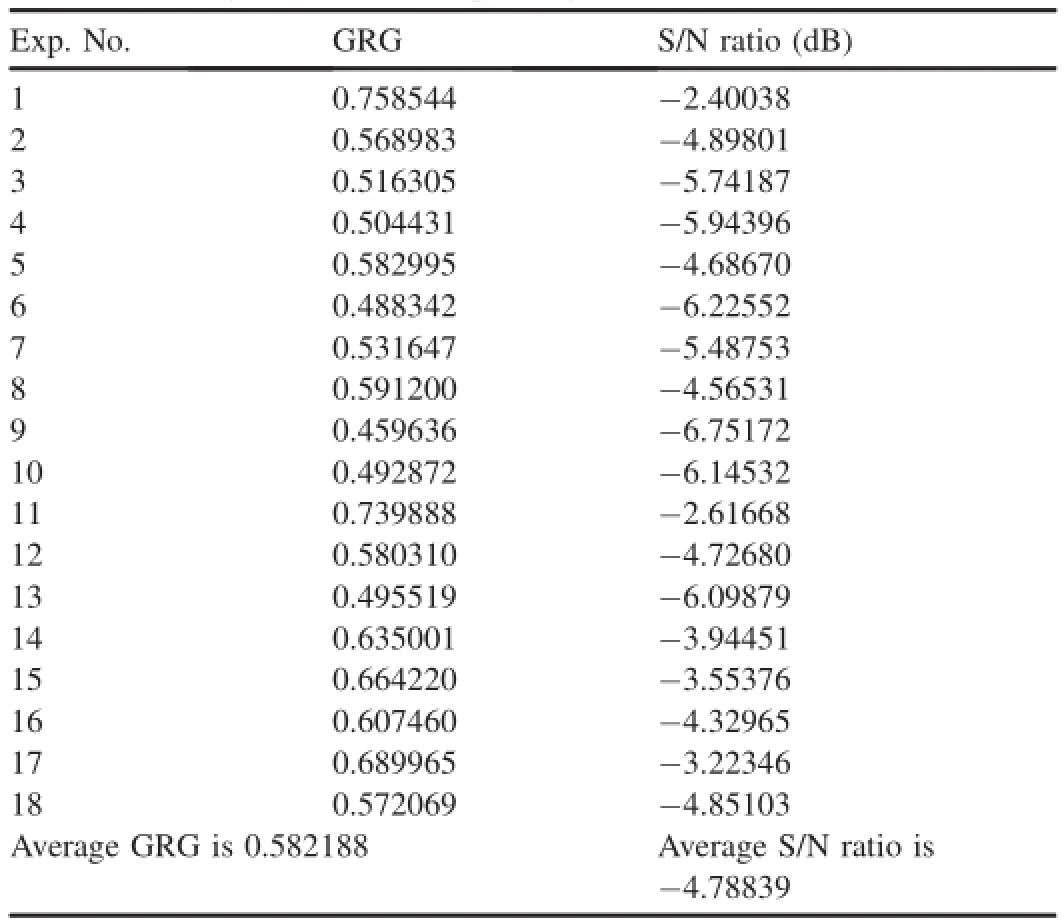
Table 11Grey relational grades with corresponding S/N ratios.

Table 12ANOVA of the S/N ratio for grey relational grade.

Table 13ANOVA of the S/N ratio for grey relational grade by considering interaction effects.

Table 14Response table for S/N ratio(Higher the better)of grey relational grade.
The analysis has been done by considering two input parameters with the GRG value and keeping an average value of other two parameters as shown in Fig.8(a-f).Fig.8(a)shows that better GRG can be obtain at plunging depth 0.21 and at tool rotational speed of 815 RPM.Fig.8(b)shows that better GRG can be obtain at lower plunging depth of 0.12-0.14 mm and at the welding speed of 98-132 mm/min.When considering shoulder diameter and plunging depth it is found that highest value GRGi.e.,>0.70 can be obtain at 0.12 mm plunging depth and 24 mm shoulder diameter as shown in Fig.8(c).When considering welding speed and tool rotational speed,it is found that better GRG can be obtain at welding speed 98-120 mm/min and tool rotational speed a 1100 RPM as shown in Fig.8(d).From Fig.8(e)it is found that GRG value of>0.64 can be obtain at shoulder diameter of 24 mm and at rotational speed of 1100 RPM.Similarly from Fig.8(f) it is found that a better GRG value can be obtain at shoulder diameter 24 mm and at welding speed 90-132 mm/min.From the overall analysis it is found that highest value of GRG can be obtain when shoulder diameter is considered as an input parameter.So it can be concluded that the shoulder diameter is the most effective parameter among all the parameters,which also found in Table 9.
5.Conclusion
To optimize the welding process parameter of AM20 magnesium alloy,Taguchi grey relational analysis was applied in this investigation.The following conclusions can be drawn from the present research:

Fig.7.Response plot for GRG.

Table 15Results of the confrmation experiment.
1.Observation concludes that the optimized process parameters are plunge depth at 0.12 mm,rotational speed at 1100 rev/min,welding speed at 98 mm/min and shoulder diameter at 24 mm for case-1 and plunging depth at 0.21 mm,rotational speed at 600 rev/min,welding speed at 98 mm/min and shoulder diameter at 24 mm for case-2.
2.The AVOVA results show that the most effective parameter is shoulder diameter for case-1 and welding speed for case-2 among allthe considered parameters.Other parameter namely plunge depth,tool rotation speed and welding speed are ranked as 2,3,and 4,respectively for case-1 and shoulder diameter,plunge depth and tool rotation speeds,are ranked as 2,3,and 4,respectively for case-2.
3.It is apparent from the ANOVA results that two factor interactions play a signifcant role on the weld quality.
4.It also found from the RSM analysis that the most effective parameter is shoulder diameter for case-1 and welding speed for case-2.
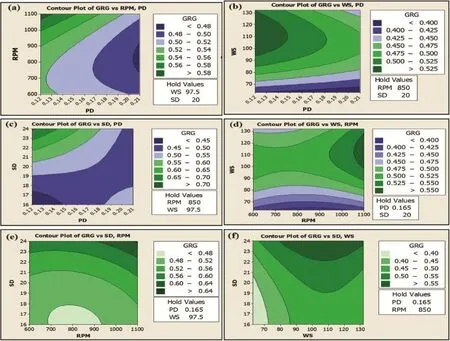
Fig.8.Analysis of the GRG by response surface method for case-1.
5.The study has proved the feasibility of Taguchi grey relational analysis method for solving multi-response optimization problem in FSW process.
Acknowledgments
The authors acknowledge the Science and Engineering Research Board,Department of Science and Technology, India,for funding the present research work[grant number SERB/F/2767/2012-13].
[1]R.C.Zeng,J.Chen,W.Dietzel,R.Zettler,J.F.D.Santos, M.L.Nascimento,K.U.Kainer,Corros.Sci.51(2009)1738.
[2]A.Dhanapal,S.R.Boopathy,V.Balasubramanian,Trans.Nonferrous Met.Soc.China 22(2012)793.
[3]M.K.Kulekci,Int.J.Adv.Manuf.Tech.39(2008)851.
[4]K.Nakata,Weld.Inter.23(2009)328.
[5]H.Zhang,S.B.Lin,L.Wu,J.C.Feng,S.L.Ma,Mater.Des.27(2006) 805.
[6]A.Dhanapal,S.R.Boopathy,V.Balasubramanian,Mater.Des.32(2011) 5066.
[7]A.Razal Rose,K.Manisekar,V.Balasubramanian,Trans.Nonferrous Met.Soc.China 21(2011)974.
[8]J.Chen,H.Fujii,Y.Sun,Y.Morisada,K.Kondoh,K.Hashimoto,Mater. Sci.Eng.A549(2012)176.
[9]L.Commin,M.Dumont,J.E.Masse,L.Barrallier,Acta.Mater.57 (2009)326.
[10]S.Rajakumar,A.Razalrose,V.Balasubramanian,Int.J.Adv.Manuf. Tech.68(2013)277.
[11]K.L.Harikrishna,J.J.S.Dilip,K.R.Choudary,V.V.S.Rao,S.R.K.Rao, G.D.J.Ram,N.Sridhar,G.M.Reddy,Trans.Indian.Inst.Met.63(2010) 807.
[12]F.Chai,D.Zhang,Y.Li,W.Zhang,Mater.Sci.Eng.568(2013)40.
[13]G.Padmanaban,V.Balasubramanian,J.K.Sarin Sundar,J.Mater.Eng. Perform.19(2010)155.
[14]A.Razal Rose,K.Manisekar,V.Balasubramanian,J.Mater.Eng. Perform.21(2012)257.
[15]K.G.Balamurugan,K.Mahadevan,J.Manuf.Proc.15(2013)659.
[16]A.A.Nia,H.Omidvar,S.H.Nourbakhsh,Mater.Des.52(2013)615.
[17]L.Yu,K.Nakata,J.Liao,J.Alloys Comp.480(2009)340.
[18]Y.Sirong,C.Xianjun,H.Zhiqiu,L.Yaohui,J.Rare Earths 28(2010) 316.
[19]C.Chien,W.Linb,T.Chenc,J.Chin.Inst.Eng.34(2011)99.
[20]S.Datta,A.Bandyopadhyay,P.K.Pal,Int.J.Adv.Manuf.Tech.39 (2008)1136.
[21]H.Aydin,A.Bayram,U.Esme,Y.Kazancoglu,O.Guven,Mater.Tech. 44(2010)205.
[22]S.Vijayan,R.Raju,S.R.K.Rao,Mater.Manuf.Proc.25(2010)1206.
[23]S.Kasman,Int.J.Adv.Manuf.Tech.68(2013)795.
[24]H.K.Kansal,S.Singh,P.Kumar,J.Mater.Proc.Tech.169(2005)427.
Received 14 July 2014;revised 30 November 2014;accepted 3 December 2014 Available online 15 January 2015
*Corresponding author.Tel.:+91 361 2582656;fax:+91 361 2582699.
E-mail address:spal@iitg.ernet.in(S.Pal).
Peer review under responsibility of National Engineering Research Center for Magnesium Alloys of China,Chongqing University.
http://dx.doi.org/10.1016/j.jma.2014.12.002.
2213-9567/Copyright 2015,National Engineering Research Center for Magnesium Alloys of China,Chongqing University.Production and hosting by Elsevier B.V.All rights reserved.
Copyright 2015,National Engineering Research Center for Magnesium Alloys of China,Chongqing University.Production and hosting by Elsevier B.V.All rights reserved.
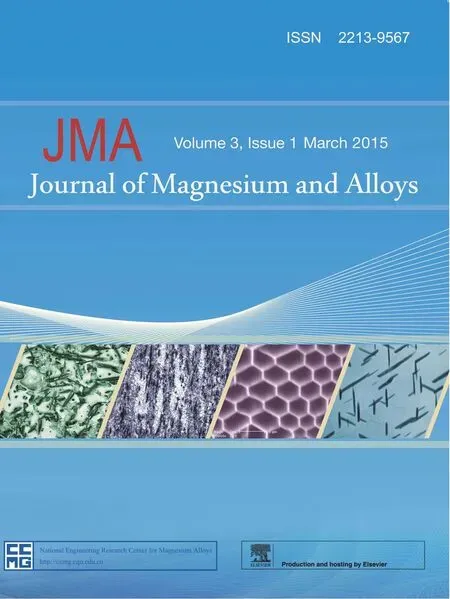 Journal of Magnesium and Alloys2015年1期
Journal of Magnesium and Alloys2015年1期
- Journal of Magnesium and Alloys的其它文章
- Improved mechanical proprieties of“magnesium based composites”with titanium-aluminum hybrids
- Effect of single Si1-xCxcoating and compound coatings on the thermal conductivity and corrosion resistance of Mg-3Sn alloy
- Investigation on mechanical properties and creep behavior of stir cast AZ91-SiCpcomposites
- Effect of microstructure evolution on mechanical property of extruded Mg-12Gd-2Er-1Zn-0.6Zr alloys
- Effects of Bi on the microstructure and mechanical property of ZK60 alloy
- Polyaspartic acid as a corrosion inhibitor for WE43 magnesium alloy
